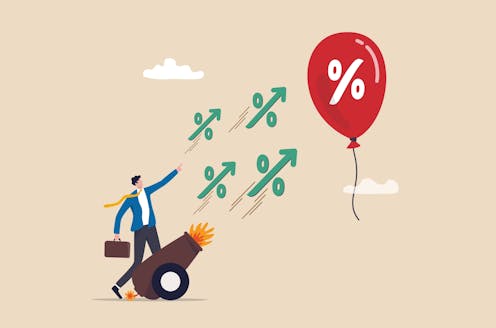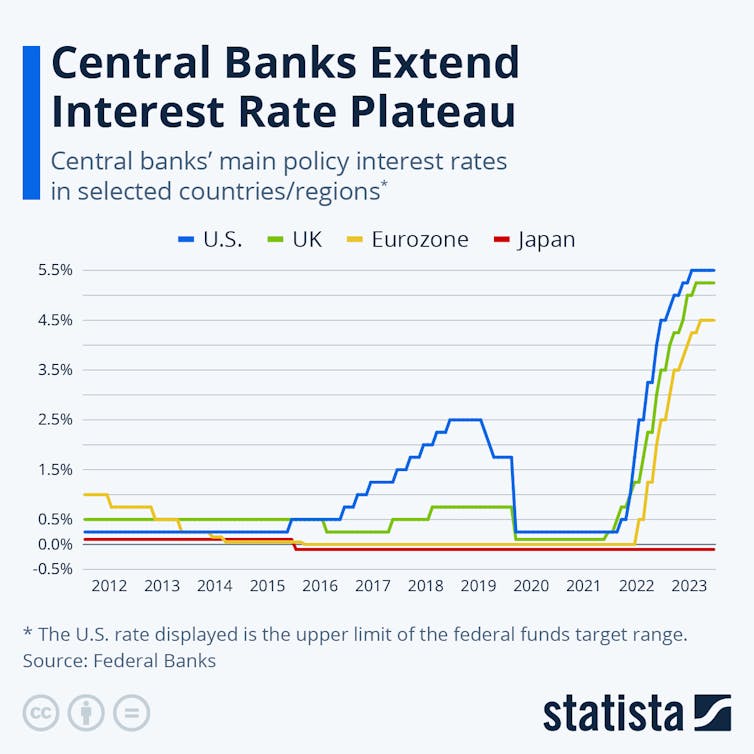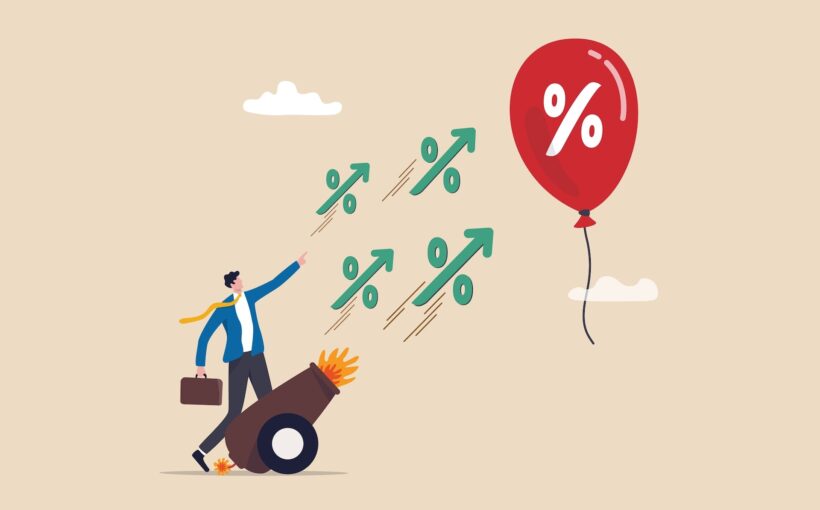
Central banks on both sides of the Atlantic kept their main interest rates unchanged for the fourth successive month in December 2023. These rates are closely watched because they set the minimum interest at which your bank borrows and lends. This determines the cost of credit for all firms and households with mortgages or other loans.
The European Central Bank (ECB), the US Federal Reserve and the UK Bank of England have raised interest rates sharply since the start of 2022. This was in response to a surge in inflation – the annual increase in consumer prices – far above the 2% rate that all these central banks now target.
But UK inflation is taking longer to respond than that of the US or EU. This has renewed debate over whether rate cuts are the best or only way to keep inflation under control. It has also caused a shift in opinions about which western economies are most at risk of recession in 2024.
Read more: Is the UK in a recession? How central banks decide and why it’s so hard to call it
Higher interest rates are designed to subdue inflation by reducing the amount people spend. Businesses and households are expected to save more when rates rise, in anticipation of greater interest payments (although that doesn’t always happen). It’s also hoped they’ll borrow less because of the extra interest they would be charged. Those with outstanding loans are left with less to spend on goods and services after paying their interest bill.
Governments are also affected. In the UK, interest on around a quarter of government debt is now linked to inflation. This means more of the budget gets channelled into interest payments, leaving less to spend on public services, when the central bank raises rates.
This restraint doesn’t happen immediately, however. When borrowers take out fixed-rate loans, they aren’t affected by higher base rates until the deal expires. Almost a million UK borrowers, for example, are still on fixed rates of 2% or below that will only come up for renewal – at current, higher rates – in the first quarter of 2024. The resulting delay of a year or more before past interest rate rises kick in makes it hard for central bankers to know when they’ve raised rates enough to cool the economy.
Read more: UK bonds have hit a 25-year high – here’s what that means for the economy
Raising interest rates can also restrain inflation by encouraging foreign investors to buy bonds and other financial assets in a country’s currency. The resulting inflow of capital is likely to strengthen its exchange rate. This makes imports cheaper and can help to slow the overall rise in prices.
A stronger currency is especially effective for curbing inflation for economies that consume a high proportion of imports, such as the UK. But it also hurts exporters, and only works if interest rates rise above those of comparable economies. This may be one reason why the Bank of England has raised its interest rates faster and further than the ECB since February 2022.

Divergence ahead
Although they hiked rates in similar fashion in 2022-23, these central banks are set to go different ways in 2024.
US rates are set to fall as inflation drops back towards the 2% target, having already slowed to 3.1% in November 2023 (from 6.4% in January). The US Federal Reserve has signalled two likely interest rate reductions, totalling 0.75%, in 2024. That’s falling into line with investors’ expectations, which can be gauged by the prices they’re prepared to pay for trading or swapping debt due at a future date and by interest rates on government bonds that mature several years from now.
While the ECB’s forward guidance is less clear, its governor has hinted at a similar downward path in 2024 because projections now point to headline inflation dropping to 2.1% in 2025 – a year earlier than previously predicted. Eurozone inflation has already slowed sharply, to 2.4% in November from 8.5% in February 2023, despite the ECB keeping its interest rates lower than the US and UK throughout the recent tightening phase. That’s largely because, even though member states set their own fiscal policy, EU rules keep them on a tight rein when it comes to spending and debt levels.
In contrast the Bank of England has warned that its base rate, already higher than the EU’s, is likely to stay at 5.25% “for an extended period of time”. Inflation (on its targeted consumer price index) slowed to 4.6% in October, well down from its peak above 11% in October 2022, but the average household is braced for more cost of living increases including a mid-winter 5% rise in the energy price cap. The recent weakening of the pound against the dollar has also added to industries’ raw material costs, and could worsen if UK interest rates fall too soon.
Read more: Inflation has affected the UK, US and Europe differently – here’s what this means for interest rates
Recession threat isn’t over
The UK economy, while hardly growing this year, has defied the Bank’s earlier forecast of a recession from the end of 2022. But because this encouraged the bank into another near-doubling of base rates – from 2.25% in October 2022 to 5.25% from August 2023 – a UK recession in 2024 is still expected by some commentators. Unfortunately, consumer spending has been less affected by higher borrowing costs than private and public investment, which ultimately drive economic growth.
More ominously for US president Joe Biden, current interest rate patterns suggest the US could also be heading for recession in a presidential election year. Most US GDP forecasts for 2024 remain in the 1.5-2.0% range, but that’s well down from the 4.9% reached in third-quarter 2023. Against this backdrop, the eurozone’s official forecast of 1.2% growth in 2024 could be seen as a relatively strong performance since it’s not expected to slow as much as the US is predicted to in 2024.
So, borrowers already hit by higher costs can expect some relief in 2024. But that’s partly due to growing concern that, with falling global commodity prices already helping to subdue inflation, central bankers may have applied the brakes too hard since 2022, endangering a global recovery.
![]()
Alan Shipman does not work for, consult, own shares in or receive funding from any company or organisation that would benefit from this article, and has disclosed no relevant affiliations beyond their academic appointment.



